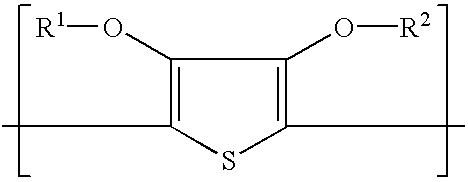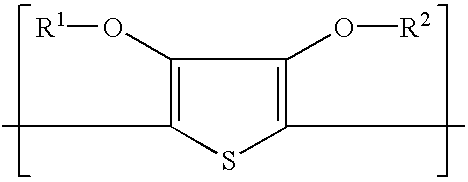Material for making a conductive pattern
a conductive pattern and material technology, applied in the field of materials and a method for making a conductive pattern, can solve the problems of high fabrication cost, limited application range, low flexibility (pliability) and stretchability, and achieve the effect of increasing the surface conductivity
- Summary
- Abstract
- Description
- Claims
- Application Information
AI Technical Summary
Benefits of technology
Problems solved by technology
Method used
Image
Examples
example 1
[0100]In the material for making a conductive pattern of Samples I to IV, the heat-differentiable element consisted of PEDOT / PSS, LATEX01 (a polystyrene latex) and FT 248 and optionally IR01 (a compound capable of converting absorbed infrared-light into heat). Samples I to IV were produced by coating 40 mL / m2 of the dispersions given in Table 2 on support nr. 01 to a wet thickness of 40 μm to produce heat-differentiable elements with the compositions given in Table 2 after drying.
[0101]
TABLE 2composition of the coating dispersionsSAM-SAM-SAM-SAM-INGREDIENT [g]PLE IPLE IIPLE IIIPLE IVSupport nr.010101011.2% aq. PEDOT / PSS dispersion417417417417LATEX0111911960301% aqueous IR01 solution—2002002005% by wt. aq. sol. of FT 2485555deionized water459259318348PEDOT / PSS [mg / m2]200200200200LATEX01 [mg / m2]10001000500250IR01 [mg / m2]—808080FT 248 [mg / m2]10101010LATEX01 / PEDOT weight ratio17.3217.328.664.33
The materials of Samples I, II, III and IV were heated in a drying...
example 2
[0112]In the material for making a conductive pattern of Samples V to XI, the heat-differentiable element consisted of PEDOT / PSS, LATEX01 (a polystyrene latex) and FT 248 and optionally polyacrylic acid, poly(vinyl alcohol) and IR01 (an infra-red absorber capable of converting absorbed infrared-light into heat). Samples V to XI were produced by coating 40 mL / m2 of the dispersions given in Table 9 on support nr. 01 to a wet thickness of 40 μm. After drying Samples V to XI had the compositions also given in Table 9.
[0113]
TABLE 9composition of the coating dispersionsSAMPLEVVIVIIVIIIIXXXIINGREDIENT [g]Support nr.010101010101011.2% aq. PEDOT / PSS disp.417417417417417417417LATEX01606060 156030151.5% aqueous PAA solution—100—————1% aqueous IR01 solution200200200200———5% aqueous PVA solution——50————50 g / L FT 2485555555deionized water318218268363518548563INGREDIENT [mg / m2]PEDOT / PSS200200200200200200200LATEX01500500500125500250125PAA—60—————PVA——100————IR0180808080———FT 24810101010101010LATEX0...
example 3
[0122]In the material for making a conductive pattern of Samples XII to XVIII, the heat-differentiable element consisted of PEDOT / PSS, a polystyrene or poly(methyl methacrylate) (PMMA) latex and FT 248. Samples XII to XVIII were produced by coating 40 mL / m of the dispersions given in Table 13 on support nr. 01 to a wet thickness of 40 μm. After drying Samples XII to XVIII had the compositions also given in Table 13. The figures in brackets are the particle sizes of the latex in nm.
[0123]
TABLE 13composition of the coating dispersionsSAMPLEINGREDIENT [g]XIIXIIIXIVXVXVIXVIIXVIIISupport nr. 01 01 01 01 01 01 011.2% ag. PEDOT / PSS disp.417417417417417417417LATEX01 60——————LATEX02— 60—————LATEX03—— 60————LATEX04——— 63———LATEX05———— 62—LATEX06————— 61—LATEX07—————— 6150 g / L FT 248 5 5 5 5 5 5 5deionized water518518518515516517517PEDOT / PSS [mg / m2]200200200200200200200PS latex [mg / m2]500( )500(68)—————PMMA latex [mg / m2]——500(68)500(54)500(52)500(49)500(64)FT 248 [mg / m2] 10 10 10 10 10 10 10LA...
PUM
| Property | Measurement | Unit |
|---|---|---|
| temperatures | aaaaa | aaaaa |
| temperature | aaaaa | aaaaa |
| temperature | aaaaa | aaaaa |
Abstract
Description
Claims
Application Information
 Login to View More
Login to View More - R&D
- Intellectual Property
- Life Sciences
- Materials
- Tech Scout
- Unparalleled Data Quality
- Higher Quality Content
- 60% Fewer Hallucinations
Browse by: Latest US Patents, China's latest patents, Technical Efficacy Thesaurus, Application Domain, Technology Topic, Popular Technical Reports.
© 2025 PatSnap. All rights reserved.Legal|Privacy policy|Modern Slavery Act Transparency Statement|Sitemap|About US| Contact US: help@patsnap.com



